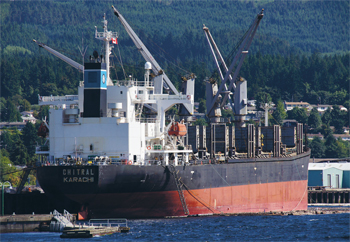Despite continuing internal problems, Pakistan is moving forward with the modernisation of its merchant fleet, although the overall size of the fleet, in ship numbers, has diminished. Over the past two years the state carrier, Pakistan National Shipping Corporation (PNSC), has acquired a number of relatively new dry bulk carriers through the second-hand market. These include the geared 46,710dwt Chitral, built in 2003; the 28,442dwt Sibi, completed in 2009; the 52,951dwt Hyderabad, built in 2004; and the 50,244dwt Multan, completed in 2002. All of these ships are Japanese-built.
They join the two gearless bulkers Malakand, a 76,830dwt vessel built in 2004, and the 65,716dwt Kaghan, which dates back to 1985. Besides the dry bulkers, PNSC has also acquired three Aframax tankers, the 107,215dwt Quetta (ex-Stena Confidence), the 107,018dwt Lahore (ex-Parthenon), and the 107,081dwt Karachi (ex-Marathon), all built by Japan’s Imabari yard in 2003.
A single combination container/breakbulk ship, the 18,257dwt Islamabad, which was built by Pakistan’s own Karachi Shipyard in 1983, has been retained for general cargo work. This gives a total of ten vessels aggregating 666,273dwt. Before the creation of Bangladesh out of East Pakistan in 1971, the Pakistan fleet reached an all-time record high of 74 vessels, but the war of December 1971 reduced this number to 57.
By 1984 the PNSC fleet was down to 31 ships of an aggregate 468,199dwt, most of which were obsolete breakbulkers. Discounting its two oldest ships, Kaghan and Islamabad, which are due to be retired in the near future, the PNSC fleet now has an average age of 9.5 years.


